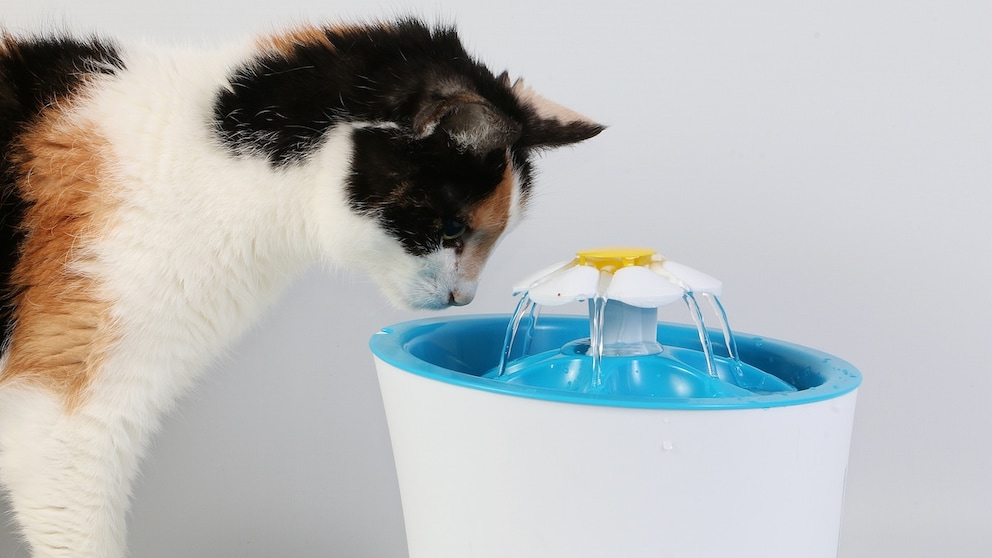January 25, 2025, 9:40 am | Read time: 4 minutes
Many cat owners ask themselves the question at some point: would you prefer a drinking fountain or the classic water bowl? The choice can be crucial, especially for cats that generally drink little.
Cats are picky animals when it comes to their water. Many cat owners are familiar with the phenomenon: the water in the bowl is ignored, while the dripping from the tap suddenly becomes an attraction. In this context, drinking fountains for cats are becoming increasingly popular. But are they really better than the conventional water bowl? PETBOOK presents the advantages and disadvantages of both options.
The Drinking Fountain: Fresh Water with an Incentive
A drinking fountain provides continuous water movement and promises numerous advantages – for both the cat and the owner.
Advantages of a Drinking Fountain
- Stimulation to drink: Cats often prefer fresh, running water as it is safer in nature than stagnant water. A drinking fountain simulates this natural state and encourages many animals to drink more. Cats, in particular, who generally drink little, can benefit from this.
- Better water quality: The water stays fresh for longer thanks to the circulation. Many models also have filters that filter out dirt, hair, and odors.
- Promoting health: Adequate fluid intake is essential to prevent kidney or urinary tract diseases, which are common in cats.
- Convenience: Cat owners need to change the water less often as a drinking fountain keeps the water clean for longer.
Disadvantages
- Cost: Drinking fountains are more expensive than a simple water bowl, both to purchase and to maintain (filter and electricity costs).
- Cleaning effort: Drinking fountains need to be cleaned regularly as bacteria can build up in the pump or filter. Some models are more difficult to clean.
- Noise level: Some cats may be frightened off by the sound of the pump or splashing water.
- Dependence on electricity: Drinking fountains usually require electricity, which makes them less flexible in terms of placement.
The Classic Water Bowl: Tried and Tested and Simple
The water bowl is the classic water dispenser and can be found in almost every cat household. Here, too, there are advantages and disadvantages.
Advantages of a Water Bowl
- Inexpensive and uncomplicated: A water bowl is inexpensive to purchase and incurs no running costs.
- Easy to clean: Empty the bowl, rinse it out, done. A water bowl is much easier to keep clean than a drinking fountain.
- Quiet and flexible: As a bowl does not require electricity, it can be placed anywhere. There is no noise to disturb the cat.
Disadvantages
- Standing water: Many cats avoid standing water as it could be potentially harmful in the wild. As a result, some cats drink less from the bowl.
- Rapid contamination: Hair, dust, or food scraps easily end up in the water, which means it needs to be changed more often.
- No additional incentive: A water bowl offers no special stimulus to encourage the cat to drink. This can be problematic, especially for cats that drink less anyway.

7 tips to get cats to drink more water

How often you should clean your pets’ water and food bowls

How to cat-proof your balcony and keep it varied
What Is the Right Choice for My Cat?
The decision between a drinking fountain and a water bowl depends on your cat’s personality and drinking habits. Observe how your cat reacts to water. If it is a water lover who finds the (dripping) tap exciting, a drinking fountain could be just the thing. If, on the other hand, your cat drinks from a bowl without any problems, this is perfectly adequate.
A combination of both can also be useful: the drinking fountain for fresh water and the water bowl as an additional option for your cat. The important thing is that the water is always clean and fresh, regardless of the method.
Conclusion: A drinking fountain can be a sensible investment, especially for cats that drink little or prefer running water. However, it does involve more cost and maintenance. The water bowl remains the simplest and cheapest solution but has disadvantages in terms of water quality and attractiveness. Ultimately, it depends on what your cat prefers – because every animal has its own taste.

